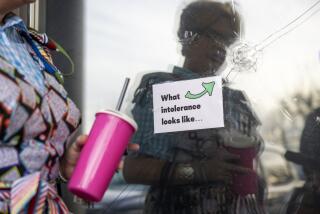Clinic’s Free Services Don’t Draw Many Zapatista Sympathizers
Paths still snake through the jungle, but the tangles of camouflaged barbed wire, networks of foxholes and treetop gun posts they once led to are gone.
The soldiers who abandoned this army base and training camp just 15 minutes by all-terrain truck from the Zapatista rebel capital also took the roof-mounted generator, hauled off the portable radio tower and dismantled the wooden watchtowers.
All the army left were a two-story barracks and some dogs--a trio of friendly, if scrawny, mutts who greet anyone who wanders into what was once a key military outpost.
The barracks now house a clinic set up by the government.
“We took a building that was the army’s, a building built for war, and we made it a place of the people, a place of peace,” said Rodolfo Dominguez, the clinic’s director.
Last year, in an effort to coax Zapatista rebels to negotiate an end to their eight-year rebellion, President Vicente Fox closed seven military bases built to monitor guerrilla strongholds in southernmost Chiapas state.
Although talks never started, the government had hoped to turn the abandoned bases into clinics, schools and Indian community centers. But all but two of the former bases have been torn down completely and only the barracks here has been put to a new use. The surviving building at the other base stands empty while the government and rebel supporters argue over what to do with it.
“The Zapatistas believe the government seized their land to build these bases,” said Amado Avendano, a Zapatista-supported candidate for Chiapas governor in 1994. “When the soldiers left, the people didn’t want the government telling them how to use that land or the abandoned military buildings.”
Here at Rio Euseba, a base built along a brook outside the unofficial Zapatista capital of La Realidad, every day sees a few dozen people hike as much as two hours from 20 nearby Indian communities to visit the clinic’s resident doctor, Eduardo Jimenez.
“We don’t distinguish between those who are Zapatistas and those who are not,” said Jimenez, 25, who speaks to most of his patients in Tojolabal, a Mayan language. “We offer free care to anyone in the area.”
But he said many Zapatista sympathizers will come only in an emergency.
“They have worked hard to create autonomous communities that offer their own medical services,” Jimenez said. “Staying away from what the government offers gives them pride.”
The clinic’s waiting room is in what used to be the barracks pantry. Its walls are lined with metal shelves stocked with medicines brought in by truck from the state capital once every three months. There is no electricity or hot water, and the clinic doesn’t have a computer.
Rosa Marina Rodriguez, who came for a checkup during the seventh month of her pregnancy, said she wouldn’t walk by the base during the eight years the army was here.
“We were all afraid of this place,” she said. “Coming around meant seeing the soldiers, and that was never good.”
Rodriguez, 20, is a Mayan who has lived all but a year of her life without having a doctor within 20 miles of her home. But although she allows Jimenez to monitor the progress of her pregnancy, she doesn’t trust modern medicine enough for the delivery of her second child.
“Our customs rely on the midwife,” she said. “Our ancestors had their children in their homes. That is how I will bring my babies into the world.”
Mario Aguilar Lopez, a 35-year-old corn farmer who walked more than an hour to reach the clinic, said soldiers used to harass people while searching for Zapatista supporters.
“The soldiers were so close that they could stop you as you walked along the road and search you for weapons,” said Aguilar, who brought his 1-year-old son, Jaime, for treatment of a rash from poison ivy. “We are a simple people. Chiapas is a simple place. Why did they need such new, large bases?”
The other base that hasn’t been razed is in the nearby Zapatista community of Guadalupe Tepeyac. It is down a road of boulders and dried mud, where cars and trucks have to yield to teams of horses and cavernous holes can snap even the heaviest axles.
Zapatista guerrillas seized the area after their Jan. 1, 1994, rebellion and controlled it until the army recaptured it the following year.
The entire civilian population of Guadalupe Tepeyac fled into the jungle and lived in exile for more than six years, returning only when the soldiers left.
They have blocked government efforts to turn the base’s whitewashed barracks into a community center.
A woman who runs a dirt-floored cafeteria said Zapatista supporters would rather tear down the base and plant corn there.
“We no longer need the Mexican government for anything,” said the graying woman who would give only her first name, Sara, and her age, 41. “For us, the government means death, not positive things like hospitals and good health.”
More to Read
Start your day right
Sign up for Essential California for news, features and recommendations from the L.A. Times and beyond in your inbox six days a week.
You may occasionally receive promotional content from the Los Angeles Times.






